OSI Systems Bundle
Decoding OSI Systems: Who Are Their Customers?
In today's complex global landscape, understanding a company's customer base is crucial for investors and strategists alike. For a company like OSI Systems, a deep dive into its customer demographics and target market reveals insights into its growth potential and competitive positioning. This analysis is particularly vital given the company's diverse operations across security, healthcare, and technology sectors. OSI Systems SWOT Analysis can provide additional context.
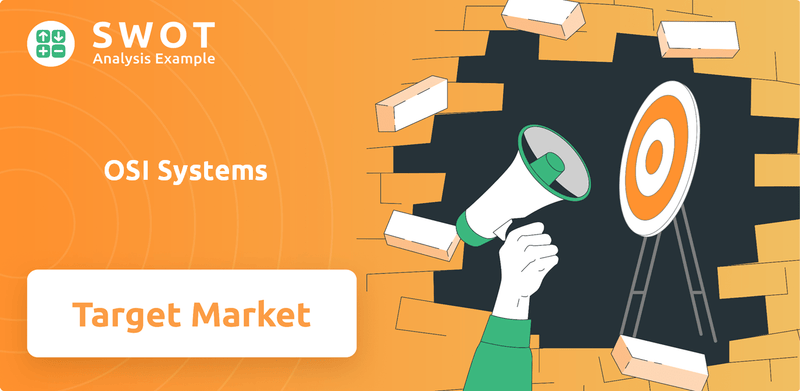
This exploration of OSI Systems' customer demographics and target market will provide a comprehensive market analysis, essential for anyone seeking to understand the company profile. We'll examine the OSI Systems target market across its key divisions, including the security sector, and explore how the company adapts to meet the evolving needs of its target audience. Furthermore, we will look at the OSI Systems customer segmentation and geographical location.
Who Are OSI Systems’s Main Customers?
Understanding the customer demographics and target market of OSI Systems is crucial for grasping its business model and growth potential. The company operates primarily in the business-to-business (B2B) sector, with a focus on governmental entities and large organizations. A detailed market analysis reveals that OSI Systems serves diverse customer segments across its three main divisions: Security, Healthcare, and Optoelectronics and Manufacturing.
The company's target audience is segmented based on the specific needs and requirements of each division. This segmentation allows OSI Systems to tailor its products and services effectively, ensuring customer satisfaction and driving revenue growth. Analyzing the customer base geographically, by industry, and by specific needs provides a comprehensive view of OSI Systems' market position and competitive landscape. For a deeper dive into the company's strategic direction, consider exploring the Growth Strategy of OSI Systems.
OSI Systems' ability to maintain a strong customer base and adapt to changing market dynamics is critical to its long-term success. The company's customer acquisition strategies and retention rates are directly influenced by its understanding of its target market and its capacity to meet the evolving demands of its clients.
The Security division, representing a significant portion of OSI Systems' revenue, primarily serves government agencies. Key clients include the U.S. Department of Homeland Security (DHS) and the Transportation Security Administration (TSA). This segment is characterized by long sales cycles and large contract values, with a strong emphasis on reliability and compliance.
The Healthcare division, operating under the Spacelabs brand, targets hospitals, physicians' offices, and medical clinics. This segment focuses on patient monitoring devices and diagnostic cardiology devices. These customers prioritize accuracy, ease of use, and integration with existing healthcare systems.
This division serves a diverse external customer base in industries such as aerospace, defense, medical imaging, and telecommunications. These customers are typically original equipment manufacturers (OEMs) and value high-quality, customized optoelectronic devices and manufacturing services. This division also supports the Security and Healthcare divisions.
The Security division accounted for 69% of total consolidated revenues. The Healthcare division contributed 10%, while the Optoelectronics and Manufacturing division represented 21%. This highlights the importance of the Security division in driving overall revenue.
OSI Systems' customer base is primarily composed of governmental entities, large organizations, and OEMs across various industries. Analyzing these segments reveals the company's strategic focus and market positioning. The company's ability to maintain strong relationships with key clients, such as the U.S. Department of Homeland Security, is crucial for its financial performance.
- Government Agencies: Primary customers for security solutions, focused on national security and trade facilitation.
- Healthcare Providers: Hospitals, clinics, and physicians' offices utilizing patient monitoring and diagnostic devices.
- OEMs: Aerospace, defense, and medical imaging companies relying on optoelectronic components and manufacturing services.
- Geographical Focus: Primarily serving customers in North America and expanding internationally.
OSI Systems SWOT Analysis
- Complete SWOT Breakdown
- Fully Customizable
- Editable in Excel & Word
- Professional Formatting
- Investor-Ready Format
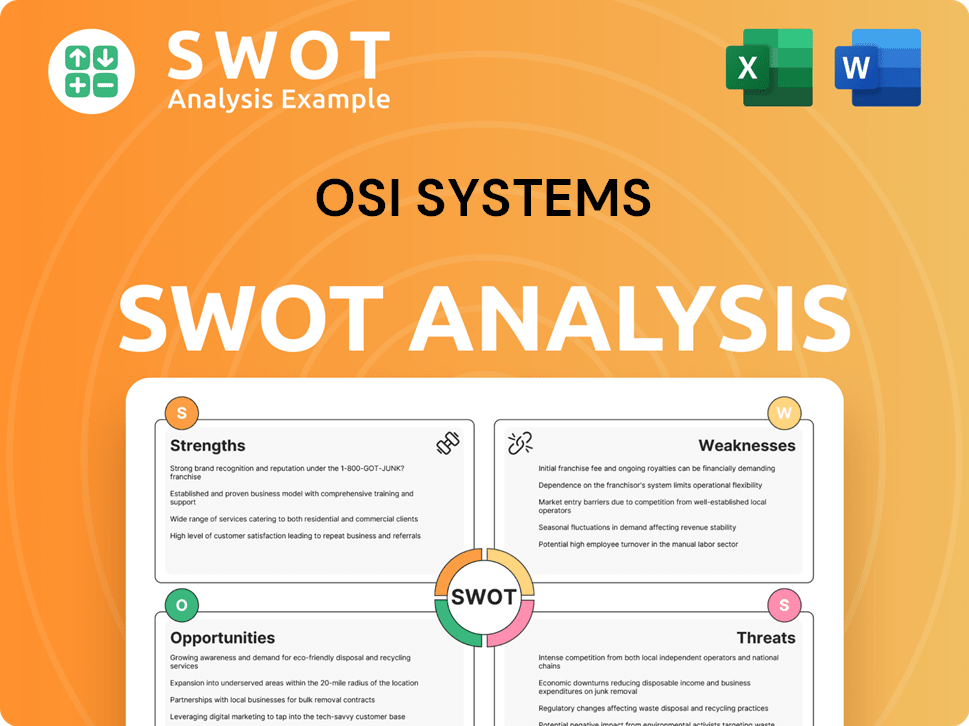
What Do OSI Systems’s Customers Want?
Understanding the needs and preferences of the customer base is crucial for the success of any business. This is especially true for a company like OSI Systems, whose diverse customer segments have very specific requirements. The company's approach to customer satisfaction is tailored to meet the unique demands of each division, ensuring that it delivers solutions that align with the critical needs of its clients.
The company's ability to meet these varied demands is reflected in its financial performance and market position. The company's focus on providing advanced technology solutions and dedicated customer service has resulted in strong customer relationships and recurring revenue streams. This customer-centric approach is a key factor in the company's sustained growth and success.
This article will explore the customer needs and preferences across OSI Systems' key divisions, highlighting the factors that drive customer decisions and the company's strategies for meeting these needs. This analysis provides insights into the company's customer demographics and how it targets its market.
Customers in the Security division, primarily government agencies and airport authorities, prioritize advanced threat detection. They require high-throughput and reliable solutions for inspecting baggage, cargo, vehicles, and people. The demand for cutting-edge, high-energy screening solutions is evident in recent contracts.
Regulatory compliance and seamless integration into existing infrastructure are critical decision-making factors. The company's solutions must meet stringent national security requirements. The company's solutions must meet stringent national security requirements.
There is a growing preference for service and support agreements. Recurring revenue from these services contributed over 30% of the Security Division's revenue in 2024, up from 20% in 2020. This indicates a desire for long-term operational support and maintenance.
The Healthcare division serves hospitals and medical facilities, with patient safety, accurate data delivery, and operational efficiency as primary drivers. Customers prefer advanced patient monitoring and diagnostic cardiology devices. The company aims to address unmet needs through continuous innovation.
The psychological driver is the desire to provide the best possible patient care, while practical needs include user-friendly interfaces and reliable performance in critical care and emergency settings. A new suite of patient monitoring products is expected by summer 2026.
Customers in the Optoelectronics and Manufacturing division, including OEMs and those in aerospace, defense, and industrial automation, seek high-quality, custom-designed optoelectronic devices. They need specialized electronic systems and optical components. Vertical integration allows control over manufacturing costs.
The customer needs and wants of OSI Systems are diverse, reflecting the varied applications of its products. The company's ability to provide tailored solutions, as highlighted in the Growth Strategy of OSI Systems, is crucial for maintaining its market position. The company's customer acquisition strategies are focused on understanding and meeting the specific needs of each segment. This approach is key to its success in a competitive market.
OSI Systems' success depends on its ability to meet the specific demands of each customer segment. The company's focus on innovation, reliability, and customer service drives its market share and customer retention rate.
- Security: Advanced threat detection, regulatory compliance, and long-term service agreements.
- Healthcare: Patient safety, accurate data, and operational efficiency.
- Optoelectronics: High-quality, custom-designed components and manufacturing services.
- All Divisions: Reliable performance, user-friendly interfaces, and tailored solutions.
OSI Systems PESTLE Analysis
- Covers All 6 PESTLE Categories
- No Research Needed – Save Hours of Work
- Built by Experts, Trusted by Consultants
- Instant Download, Ready to Use
- 100% Editable, Fully Customizable
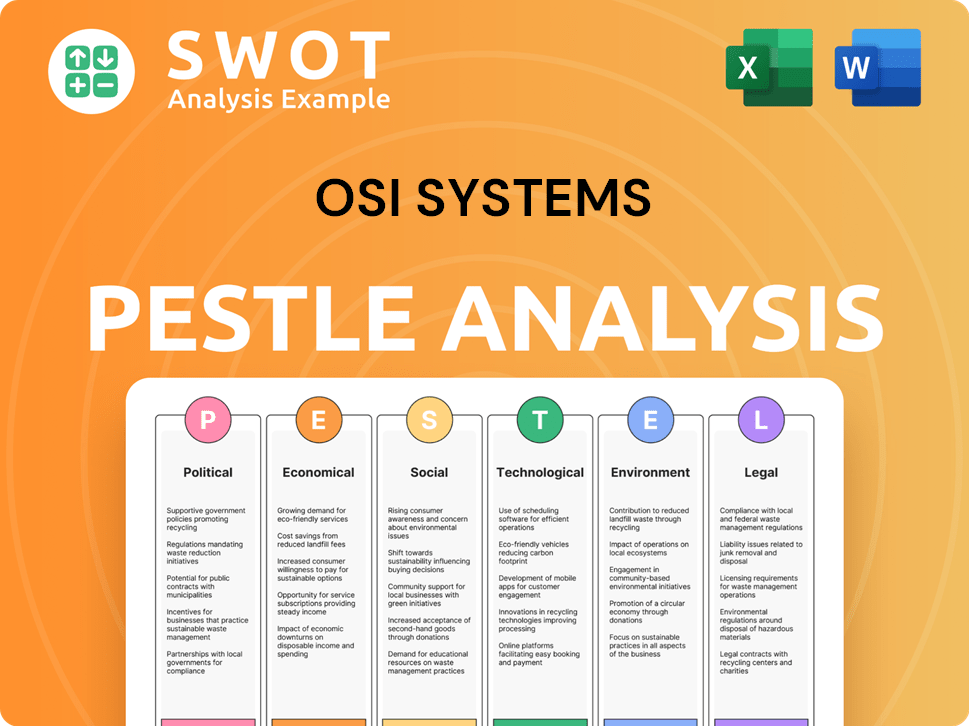
Where does OSI Systems operate?
OSI Systems maintains a significant global presence, crucial for its operations and market reach. The company's operations span across multiple continents, with offices and production facilities in over a dozen countries. This widespread geographical footprint supports its vertically integrated business model, enabling efficient delivery and responsiveness to market demands.
The company's ability to operate in over 100 countries worldwide highlights its extensive reach. This expansive presence is a key factor in its ability to serve a diverse customer base and capitalize on international opportunities. Its global strategy is essential for maintaining a competitive edge in the security, healthcare, and optoelectronics markets.
A key aspect of understanding the Owners & Shareholders of OSI Systems involves examining its geographical market presence. This global reach is supported by strategic acquisitions and contracts, further strengthening its position in key markets.
In the Security division, the company holds a strong market share, particularly in ports and borders. Its CertScan software drives over half of this market share. The U.S. market remains a strong base, with numerous contracts awarded by the U.S. federal government.
The company has secured substantial contracts with the U.S. government. Contracts with the Departments of Defense (DOD) and Homeland Security (DHS) totaled at least $328.9 million with Customs and Border Patrol (CBP) as of July 2024. This demonstrates a strong reliance on and relationship with U.S. government agencies.
Beyond the U.S., the company has secured significant international orders. A $76 million contract for an international airport was secured in March 2025. A $59 million contract was also secured from an overseas customer in the European-Middle East-Africa region in January 2024.
The Optoelectronics and Manufacturing division has a global footprint with manufacturing facilities. These facilities are located in the United Kingdom, U.S., Mexico, India, Malaysia, and Indonesia. This widespread manufacturing supports its diverse customer base globally.
Recent expansions and strategic market entries are evident through new contracts and acquisitions. For example, a recent acquisition of an RF-based solutions business, primarily serving defense customers, contributed $29 million to Q3 fiscal 2025 revenue and secured a $32 million international order for long-range secure communication systems. This demonstrates strategic growth in defense markets globally.
- The company's diversified customer base includes governments, airports, and healthcare providers.
- This diversification mitigates sector-specific risks and enhances its resilience.
- The company's global presence is a key factor in its revenue generation and market share.
- The company continues to expand its international footprint through strategic acquisitions and contracts.
OSI Systems Business Model Canvas
- Complete 9-Block Business Model Canvas
- Effortlessly Communicate Your Business Strategy
- Investor-Ready BMC Format
- 100% Editable and Customizable
- Clear and Structured Layout
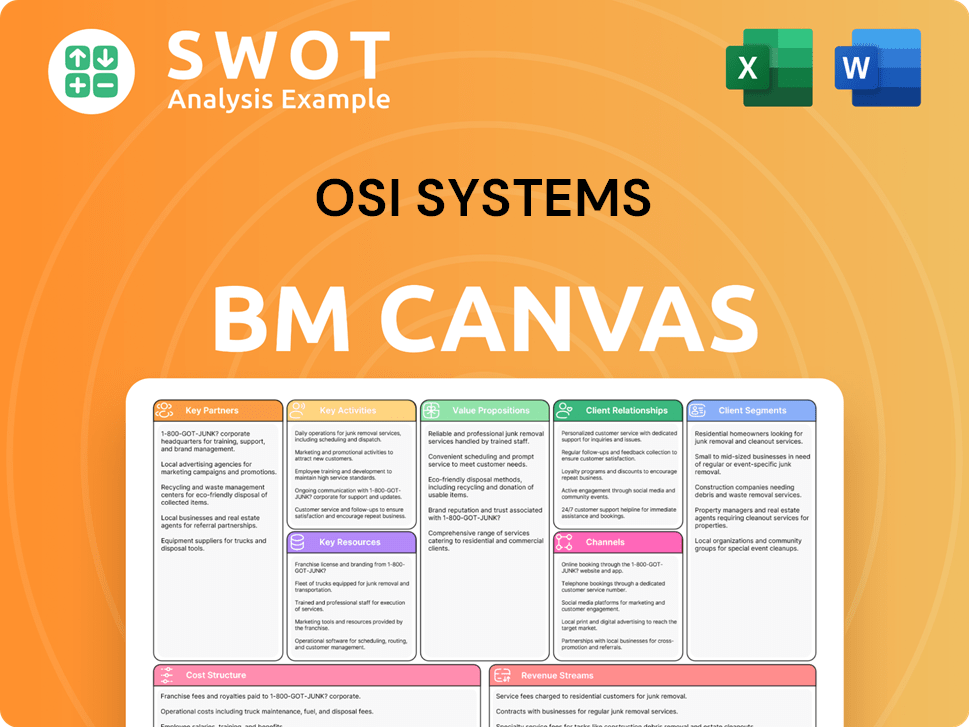
How Does OSI Systems Win & Keep Customers?
The [Company Name] employs a multi-faceted approach to customer acquisition and retention, focusing on securing large, long-term contracts and providing comprehensive service and support. This strategy leverages the company's vertical integration, strong industry reputation, and a shift towards service-based revenue. The goal is to build a recurring revenue stream and enhance customer loyalty.
A key element of their customer acquisition strategy involves securing significant contracts with governmental agencies and major international organizations. These large-scale deals not only boost revenue but also establish credibility, acting as strong testimonials for future acquisitions. This approach is complemented by a focus on providing exceptional service and support for its installed base of systems, which is crucial for customer retention.
Customer retention is also heavily influenced by the strategic shift towards increasing predictable, recurring revenue through maintenance and software support. This is exemplified by service-based contracts and capitalizing on the company's extensive global deployment of systems, creating a recurring revenue stream that reduces earnings volatility and enhances valuation. This approach allows for greater responsiveness to customer requirements and tailoring of solutions.
Securing large, long-term contracts with governmental agencies is a primary customer acquisition strategy. Recent examples include a $17 million order for cargo and vehicle inspection systems from a North American customer as part of a multi-year framework agreement established in 2024. Multiple indefinite delivery/indefinite quantity (IDIQ) contracts with the Transportation Security Administration (TSA) totaling over $22 million in 2024 further illustrate this approach.
Customer retention is driven by providing comprehensive service and support. In 2024, service and upgrade agreements contributed over 30% of the Security Division's revenue, a significant increase from 20% in 2020. A $47 million service-based contract secured in May 2025 to maintain and enhance inspection systems and software exemplifies this focus.
The company is strategically shifting its revenue model to increase predictable, recurring revenue through maintenance and software support. This approach builds a recurring revenue moat that reduces earnings volatility and enhances valuation. A $27 million contract received in September 2024 from a U.S.-based customer for maintenance service and technology support is a good example.
Vertical integration enhances customer retention by controlling manufacturing costs and improving time-to-market. Continuous research and development efforts, focused on expanding and enhancing product portfolios, also contribute to customer loyalty. The company's participation in industry conferences strengthens its market presence and potential for new engagements.
The company's success relies on strategic customer acquisition and retention methods. This includes securing large contracts, emphasizing service-based revenue, and leveraging vertical integration and R&D.
- Securing large, long-term contracts with governmental agencies and international organizations.
- Providing comprehensive service and support for its installed base of systems.
- Shifting towards a revenue model that increases predictable, recurring revenue.
- Leveraging vertical integration to enhance customer retention.
OSI Systems Porter's Five Forces Analysis
- Covers All 5 Competitive Forces in Detail
- Structured for Consultants, Students, and Founders
- 100% Editable in Microsoft Word & Excel
- Instant Digital Download – Use Immediately
- Compatible with Mac & PC – Fully Unlocked
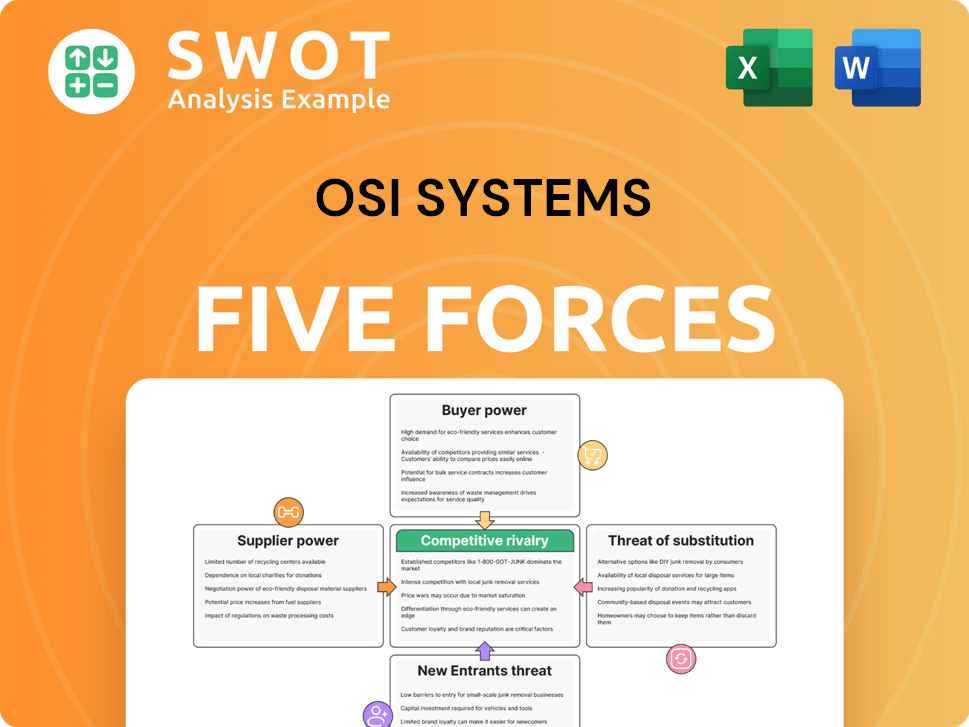
Related Blogs
- What are Mission Vision & Core Values of OSI Systems Company?
- What is Competitive Landscape of OSI Systems Company?
- What is Growth Strategy and Future Prospects of OSI Systems Company?
- How Does OSI Systems Company Work?
- What is Sales and Marketing Strategy of OSI Systems Company?
- What is Brief History of OSI Systems Company?
- Who Owns OSI Systems Company?
Disclaimer
All information, articles, and product details provided on this website are for general informational and educational purposes only. We do not claim any ownership over, nor do we intend to infringe upon, any trademarks, copyrights, logos, brand names, or other intellectual property mentioned or depicted on this site. Such intellectual property remains the property of its respective owners, and any references here are made solely for identification or informational purposes, without implying any affiliation, endorsement, or partnership.
We make no representations or warranties, express or implied, regarding the accuracy, completeness, or suitability of any content or products presented. Nothing on this website should be construed as legal, tax, investment, financial, medical, or other professional advice. In addition, no part of this site—including articles or product references—constitutes a solicitation, recommendation, endorsement, advertisement, or offer to buy or sell any securities, franchises, or other financial instruments, particularly in jurisdictions where such activity would be unlawful.
All content is of a general nature and may not address the specific circumstances of any individual or entity. It is not a substitute for professional advice or services. Any actions you take based on the information provided here are strictly at your own risk. You accept full responsibility for any decisions or outcomes arising from your use of this website and agree to release us from any liability in connection with your use of, or reliance upon, the content or products found herein.